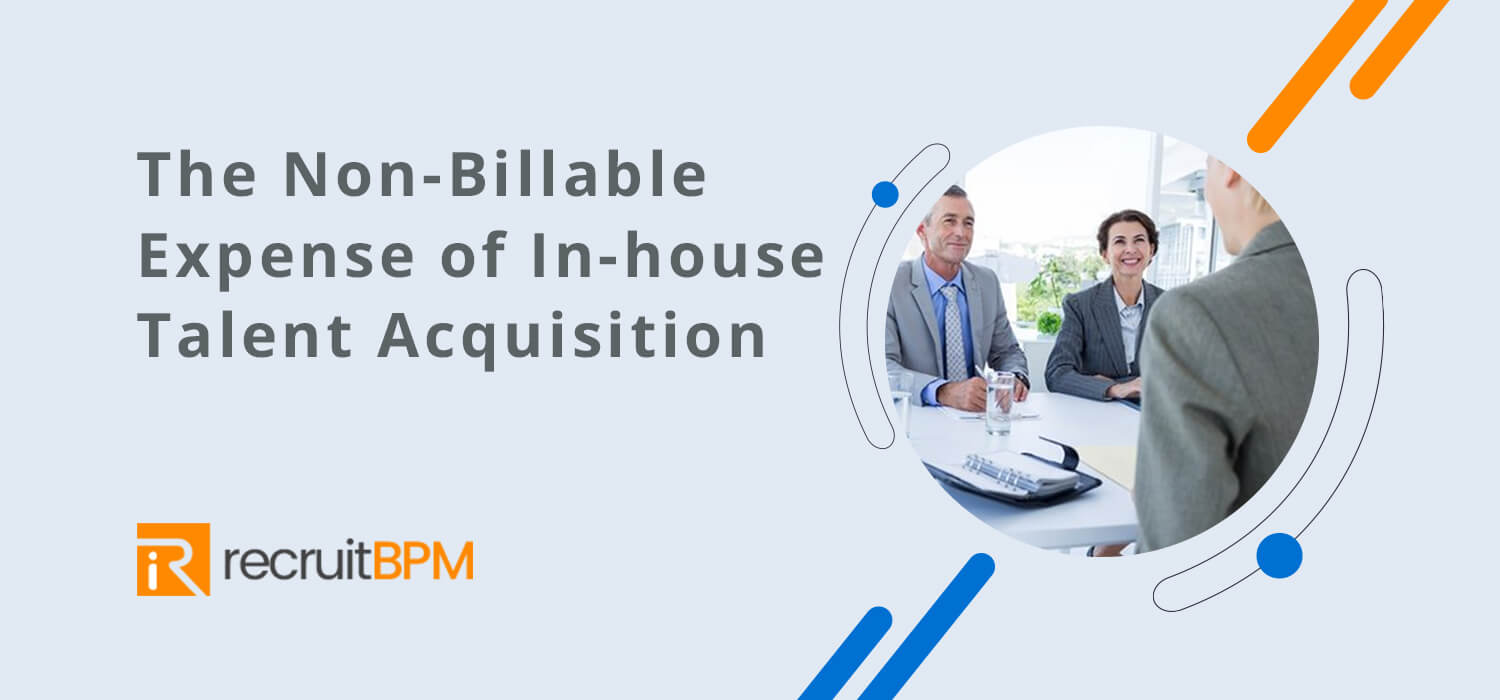This blog highlights the comparison between expanding the in-house talent acquisition and using B2B talent acquisition specialists. The hidden costs and risks of using in-house talent acquisition are uncovered in brief detail. The benefits of externally managed talent acquisition are discussed in terms of monetary resources and the time value of organizational operations and functions. Lack of growth-oriented talent and employee retention rate has been the greatest inconvenience for CEOs and company managers. It is often very hard for SMBs to cope with the demands of keeping up with the fast-paced marketplaces. Companies find it hard to organize counseling and talent coaching sessions for their employees amidst the stress of managing overhead operational resources.
The quest of finding the right resource who understands the core business values along with his/her job responsibilities is something no HR can master at. This puts the administration in a constant dilemma. The company is investing its time and resources in employees, but the achievement of the anticipated productivity levels awaits. A stagnant state is established wherein the expansion quotient of the company begins to fall owning to the absence of a business growth mindset among the employees.
The answer to this jeopardizing state of any company is to deploy a different strategy when it comes to the allocation of resources and employing professionals – An externally managed talent acquisition service provider.
Uncovering the Hidden Costs of In-house Talent Acquisition
Any business entity ranging from mid-level to fully established scale is possibly incurring costs that are apparently imperative for the growth and sustainability of the business. However, these overhead costs are in fact consuming the resources of the company which could otherwise be devised for the primary indispensable needs of the business. Companies strive for in-house talent acquisition and dedicate significant time and resources to the onboarding process of their employees. The amount of investment dispensed in the onboarding of in-house talent acquisition is generally perceived as an inevitable cost.
A compromise is made in an understanding that a breakeven will occur and the company’s investment in their employees would start benefiting the company’s interests along the way. This process of enhancing the company’s interests by focusing on each employee puts the company in a challenging position amidst a very competitive market. Quoted from the survey report of 210 CEOs by Harvard Business School, “Typical mid-level managers require 6 months to reach their breakeven point”. In effect, the company is missing out on a big chunk of market share in the venture of in-house talent acquisition. Before we move into the depth of non-billable expense of resource management, let’s have a look at some associated risks and costs of in-house talent acquisition.
As hard as it is to find just the right resource for the company, it gets even harder to anticipate the risks and costs associated with the in-house talent acquisition. A simplified yet brief insight into this problem is enlisted below.
HR Risks and Costs of In-house Talent Acquisition
There has always been a talk about communication gaps and understanding between the HR and the technical departments of companies. Often, HR is valuing prospective employees on factors that are in contradiction with the requirements of the technical teams. This situation fills the position, but the void remains and the company suffers despite bringing in a new workforce.
The cost of in-house talent acquisition dissipates a significant proportion when compared to the operational costs of the business. The costs of advertisements, applications’ screening time, and interviewing the potential candidates add to the collective overhead of business costs.
On-Boarding and Training Costs
New employees are potential assets but only after they’re fully accustomed to the workplace environment, and practices of the company. Until then, the company invests time and resources to familiarize them with the values and culture of the workplace. This hefty process begins from onboarding processes to ice-breaker sessions and ends after a whole long series of training sessions. Every step of the way, the company bears the cost to optimize the growth and productivity of new recruitments.

Costs of Salary and Benefits
The cost of salary is the only up-front cost that can be foreseen during the in-house talent acquisition. However, the gravity of the overhead costs is far deeper than just the allocation of resources for employees. Not every employee is producing the exact same results in any organization. It demands a distinguished approach from the administration when it comes to benefiting the employees. At this point, the salary overheads become a trivial proportion when compared to the overheads for perks, bonuses, and allowances. For each salary overhead, the following overheads incur as part and parcel of every in-house talent acquisition process.

Employee Retention Risks
Business strategies have evolved over the course of time. Companies now focus and work on satisfying their employees with the workplace environment to optimize the employee retention rate. Nevertheless, just like the customers, we can never keep all the employees satisfied. This risk of losing employees puts a company under constant pressure. They start allocating perks and benefits to keep their employees retained for a longer period. Hence, the investment made in the in-house talent acquisition processes is fruitful.
An Insight into Numbers – Costs
- Quoted by AU Talent, the average annual salary of a full-time IT professional rounds up to $138,112.
- The same source quotes that a company on average dispenses around $20,000 for every IT employee in bonuses and perks.
- Training Magazine quoted an overhead of around USD $1544 per employee is dissipated on training them annually.
- Companies pay a Fringe Benefits Tax at 47% for all the additional perks and bonuses given to the employees annually.
- According to Boston Business Journal, the salary plus benefits usually totals in 1.25 to 1.4 times base salary range. Hence, the salary-plus-benefits package for an employee who makes $100,000 a year could equal $125,000 to $140,000.
- According to Robert Half International, 34% of the CFOs say bad hires cost 17% of the manager’s time in supervision. Effectively, it means that a bad hire consumes one full day a week for his manager in supervising his performance.
- The annual report of SHRM on Human Capital Benchmarking approximated that companies spend around 42 days, $4,129 per hire.
- During the joint ventures, RecruitBPM observed that lack of training and bad hires cost the companies around USD $170,000 annually.
All the costs cannot be eliminated since some essential functions of companies are better performed with integrated in-house talent acquisition. However, the aforementioned overheads are cut down by outsourcing the essential workforce, pre-trained for performing the functions effectively. And that is where we deliver talent acquisition services to companies across the globe. We enable them to operate at relatively low overhead costs by connecting them with just the right resource remotely. RecruitBPM is a market-leader when it comes to offering the best applicant tracking system to eliminate in-house talent acquisition nuisances. You can also request a free demo ATS if you are interested to evaluate the software on a trial basis.
About the Author
Ahmad Osama
With 4+ years of experience in creating and optimizing blog pages, I have gained expertise in drafting copies that are not only SEO enriched but are also engaging for readers. Most of my writing experience is related to drafting blogs for B2B and SaaS-based solutions.























